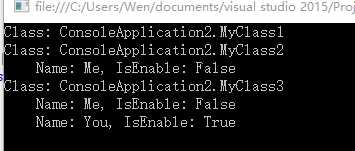标签:
【博主】反骨仔 【原文地址】http://www.cnblogs.com/liqingwen/p/5911289.html
特性具有以下属性:
(1)特性可向程序中添加元数据。元数据是有关在程序中定义的类型的信息。所有的 .NET 程序集都包含指定的一组元数据,这些元数据描述在程序集中定义的类型和类型成员。可以添加自定义特性,以指定所需的任何附加信息。
(2)可以将一个或多个特性应用到整个程序集、模块或较小的程序元素(如类和属性)。
(3)特性可以与方法和属性相同的方式接受参数。
(4)程序可以使用反射检查自己的元数据或其他程序内的元数据。
特性可以放置在几乎所有的声明中(但特定的特性可能限制在其上有效的声明类型)。在 C# 中,特性的指定方法为:将括在方括号中的特性名置于其应用到的实体的声明上方。它必须位于所应用于的元素的紧前面并与该元素在同一行。
1 [Serializable] //使用特性 SerializableAttribute 2 internal class MyClass 3 { 4 [DllImport("user32.dll")] //使用特性 DllImportAttribute 5 private static extern void Do(); 6 7 #region 一个声明上可放置多个特性 8 9 private void MethodA([In][Out]ref double n) { } 10 private void MethodB([In, Out]ref double n) { } 11 12 #endregion 一个声明上可放置多个特性 13 14 #region 某些特性对于给定实体可以指定多次 15 16 [Conditional("DEBUG"), Conditional("TEST1")] 17 private void TraceMethod() { } 18 19 #endregion 某些特性对于给定实体可以指定多次 20 }
【注意】根据约定,所有特性名称都以单词“Attribute”结束,以便将它们与“.NET Framework”中的其他项区分。但是,在代码中使用特性时,不需要指定 attribute 后缀。
许多特性都有参数,而这些参数可以是定位参数、未命名参数或命名参数。任何定位参数都必须按特定顺序指定并且不能省略,而命名参数是可选的且可以按任意顺序指定。首先指定定位参数。例如,这三个特性是等效的:
1 [DllImport("user32.dll")] 2 [DllImport("user32.dll", SetLastError=false, ExactSpelling=false)]
第一个参数(DLL 名称)是定位参数并且总是第一个出现,其他参数为命名参数。在这种情况下,两个命名参数均默认为 false,因此可将其省略。
特性的目标是应用该特性的实体。例如,特性可以应用于类、特定方法或整个程序集。默认情况下,特性应用于它后面的元素。但是,您也可以显式标识要将特性应用于方法还是它的参数或返回值。
若要显式标识特性目标,语法:
[target : attribute-list]
| C# | 适用对象 |
| assembly | 整个程序集 |
| module | 当前程序集模块 |
| field | 在类或结构中的字段 |
| event | event |
| method | 方法或 get 和 set 属性访问器 |
| param | 方法参数或 set 属性访问器参数 |
| property | 属性 |
| return | 方法、属性索引器或 get 属性访问器的返回值 |
| type | 结构、类、接口、枚举或委托 |
//示例:将特性应用于程序集和模块 [assembly: AssemblyTitle("assembly 4.6.1")] [module: CLSCompliant(true)]
1 //示例:将特性应用于方法、方法参数和方法返回值 2 3 //默认:应用于方法 4 [SomeAttr] 5 int Method1() { return 0; } 6 7 //指定应用于方法 8 [method: SomeAttr] 9 int Method2() { return 0; } 10 11 //指定应用于返回值 12 [return: SomeAttr] 13 int Method3() { return 0; }
以下列表包含特性的几个常见用途:
(1)在 Web 服务中,使用 WebMethod 特性来标记方法,以指示该方法应该可通过 SOAP 协议进行调用。
(2)描述当与本机代码进行交互操作时如何封送方法参数。有关更多信息。
(3)描述类、方法和接口的 COM 属性。
(4)使用 DllImportAttribute 类调用非托管代码。
(5)在标题、版本、说明或商标方面描述您的程序集。
(6)描述要持久性序列化类的哪些成员。
(7)描述如何映射类成员和 XML 节点以便进行 XML 序列化。
(8)描述方法的安全要求。
(9)指定用于强制安全性的特性。
(10)由实时 (JIT) 编译器控制优化,以便易于调试代码。
(11)获取有关调用方的信息的方法。
通过定义一个特性类,可以创建您自己的自定义特性。该特性类直接或间接地从 Attribute 派生,有助于方便快捷地在元数据中标识特性定义。
1 /// <summary> 2 /// 角色特性 3 /// </summary> 4 /// RoleAttribute:特性的名称,继承 Attribute,为自定义特性 5 [AttributeUsage(AttributeTargets.Class | AttributeTargets.Struct)] 6 public class RoleAttribute : Attribute 7 { 8 private string _name; 9 10 /// <summary> 11 /// 启用标识 12 /// </summary> 13 /// IsEnable:命名参数 14 public bool IsEnable { get; set; } 15 16 /// <summary> 17 /// 构造函数 18 /// </summary> 19 /// <param name="name"></param> 20 /// name:定位参数 21 public RoleAttribute(string name) 22 { 23 _name = name; 24 } 25 }
1 [Role("Me", IsEnable = true)] //调用特性的方式 2 public class OurClass 3 { 4 5 }
构造函数的参数是自定义特性的定位参数,任何公共的读写字段或属性都是命名参数。【注意】 AttributeUsage 特性,在这里它使得 Role 特性仅在类和 struct 声明中有效。
1 [AttributeUsage(AttributeTargets.Class | AttributeTargets.Struct, AllowMultiple = true)] //AllowMultiple:该值指示能否为一个程序多次使用该特性 2 public class RoleAttribute : Attribute 3 { 4 //... ... 5 }
1 [Role("You")] //在同一个类上多次使用 2 [Role("Me", IsEnable = true)] 3 public class OurClass 4 { 5 //... ... 6 }
【注意】如果特性类包含一个属性,则该属性必须为读写属性。
如果没有检索自定义特性的信息和对其进行操作的方法,则定义自定义特性并将其放置在源代码中就没有意义。使用反射,可检索用自定义特性定义的信息。主要方法是 GetCustomAttributes,它返回对象数组,这些对象在运行时等效于源代码特性。

1 /// <summary> 2 /// 角色特性 3 /// </summary> 4 /// RoleAttribute:特性的名称,继承 Attribute,为自定义特性 5 [AttributeUsage(AttributeTargets.Class | AttributeTargets.Struct)] 6 public class RoleAttribute : Attribute 7 { 8 private string _name; 9 /// <summary> 10 /// 启用标识 11 /// </summary> 12 public bool IsEnable { get; set; } 13 14 /// <summary> 15 /// 构造函数 16 /// </summary> 17 /// <param name="name"></param> 18 public RoleAttribute(string name) 19 { 20 _name = name; 21 } 22 }
1 [Role("Me", IsEnable = true)] 2 public class OurClass 3 { 4 //... ... 5 }
概念上等效于
1 RoleAttribute role = new RoleAttribute("Me"); 2 role.IsEnable = true;
但是,直到查询 OurClass 来获取特性后才会执行此代码。对 OurClass 调用 GetCustomAttributes 会导致按上述方式构造并初始化一个 RoleAttribute 对象。如果该类具有其他特性,则按相似的方式构造其他特性对象。然后 GetCustomAttributes 返回 RoleAttribute 对象和数组中的任何其他特性对象。之后就可以对此数组进行迭代,确定根据每个数组元素的类型所应用的特性,并从特性对象中提取信息。
这里,定义一个自定义特性,将其应用于若干实体并通过反射进行检索。
1 /// <summary> 2 /// 角色特性 3 /// </summary> 4 [AttributeUsage(AttributeTargets.Class | AttributeTargets.Struct, AllowMultiple = true)] 5 public class RoleAttribute : Attribute 6 { 7 private readonly string _name; 8 9 /// <summary> 10 /// 启用标识 11 /// </summary> 12 public bool IsEnable { get; set; } 13 14 /// <summary> 15 /// 构造函数 16 /// </summary> 17 /// <param name="name"></param> 18 public RoleAttribute(string name) 19 { 20 _name = name; 21 } 22 23 public string GetName() 24 { 25 return _name; 26 } 27 }
1 class MyClass1 2 { 3 4 } 5 6 [Role("Me")] 7 class MyClass2 8 { 9 10 } 11 12 [Role("Me"), Role("You", IsEnable = true)] 13 class MyClass3 14 { 15 16 }
1 class Program 2 { 3 static void Main(string[] args) 4 { 5 Output(typeof(MyClass1)); 6 Output(typeof(MyClass2)); 7 Output(typeof(MyClass3)); 8 9 Console.Read(); 10 } 11 12 /// <summary> 13 /// 输出 14 /// </summary> 15 /// <param name="t"></param> 16 static void Output(Type t) 17 { 18 Console.WriteLine($"Class: {t}"); 19 20 var attributes = t.GetCustomAttributes(); 21 foreach (var attribute in attributes) 22 { 23 var attr = attribute as RoleAttribute; 24 25 if (attr == null) 26 { 27 return; 28 } 29 30 Console.WriteLine($" Name: {attr.GetName()}, IsEnable: {attr.IsEnable}"); 31 } 32 } 33 }

--预览版,整理完毕后发布到首页--
标签:
原文地址:http://www.cnblogs.com/liqingwen/p/5911289.html